The article was written exclusively for Investing.com
- Coffee rises to the highest price since 2014 in July
- Orange juice moves to a multi-year peak
- Sugar and cotton rise to the highest prices in years in August
- Cocoa is showing signs of bullish life
- Levels to watch in the cocoa market - NIB is the cocoa ETN product
The tidal wave of central bank liquidity began in early 2020 when the Fed cut the short-term Fed Funds rate to zero and began buying debt securities to the tune of $120 billion per month. As of August 2020, the monetary policy stance has not changed. Government stimulus in the trillions has been a tsunami over the past fifteen months. The current US budget and new stimulative initiatives, including infrastructure rebuilding and other programs, will continue even if the Fed tightens credit because of rising inflationary pressures.
The bottom line is that the inflationary seeds from monetary and fiscal stimulus have been blooming over the past year. Commodities are highly sensitive to the economic condition as inflation erodes money’s purchasing power, causing raw materials costs and prices to rise. Gold, a leading inflation barometer, rose to a record high at $2063 in August 2020. While gold corrected, it passed the bullish baton to other commodities. Earlier this year, grain prices rose to over eight-year highs as corn, soybeans, and wheat soared. In May, lumber, copper, and palladium reached new record prices. Energy prices rose to multi-year highs over the past months.
In July, the soft commodities began to rise as the bullish baton passed to the sector of luxury commodities. Coffee, sugar, cotton, and even frozen concentrated orange juice futures (FCOJ) have already reached multi-year highs. Cocoa, the primary ingredient in chocolate confectionery products, could be the next soft commodity to soar. The iPath® Bloomberg Cocoa Subindex Total Return (SM) ETN (NYSE:NIB) moves higher and lower with the price of ICE cocoa futures.
Coffee rises to the highest price since 2014 in July
In April 2019, nearby ICE coffee futures reached the lowest price since 2005 at 86.35 cents per pound. The first clue that something was percolating in the coffee market was when the soft commodity fell to a higher low at 92.70 cents in June 2020 during the height of the global pandemic.
The bullish stars lined up for the coffee futures market in 2021 as rising inflationary pressures and a frost in Brazil pushed the price to the highest level in years.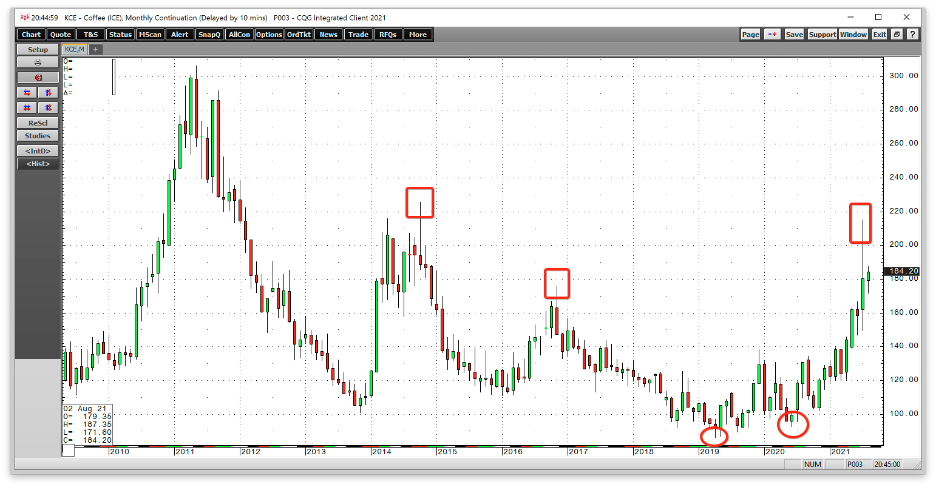
Source: CQG
The chart shows that nearby coffee futures blow through the first technical resistance level at the November 2016 $1.76 per pound high as a hot knife goes through butter. The price continued to explode in July, reaching $2.1520 per pound, the highest level since October 2014 when coffee futures rose to $2.2550.
Brazil is the world’s leading producer and exporter of three soft commodities; coffee, oranges, and sugar.
FCOJ moves to a multi-year peak
Frozen concentrated orange juice futures are the least liquid soft commodity that trades on the Intercontinental Exchange (ICE). The frost, inflationary pressures, and logistic issues caused by COVID-19 pushed orange prices to the highest price in nearly three years.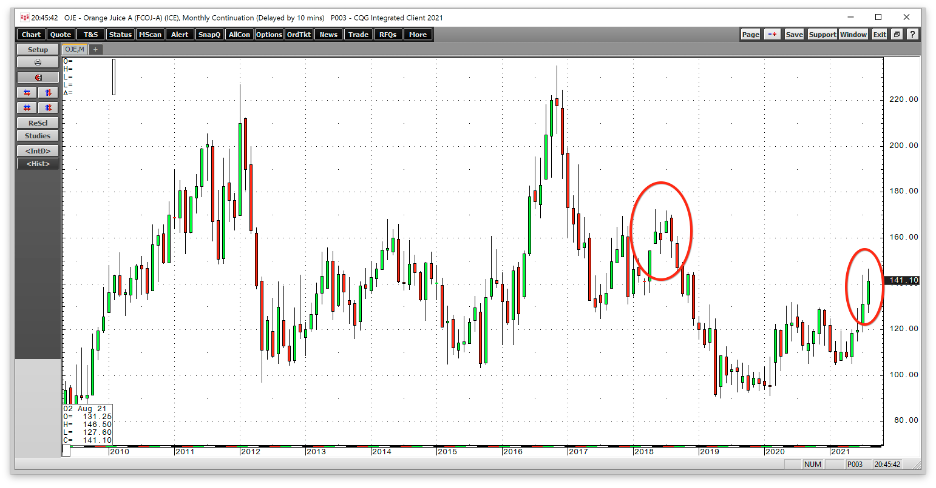
Source: CQG
This week, nearby FCOJ reached $1.4650 per pound, the highest price since October 2018. The trend remains higher, with the May 2018 $1.7245 the upside technical target for FCOJ prices.
Sugar and cotton rise to the highest prices in years in August
Brazil is the world’s leading producer and exporter of free-market sugar. Sugar is both a food and a fuel in Brazil as the sweet commodity is the primary ingredient in ethanol production.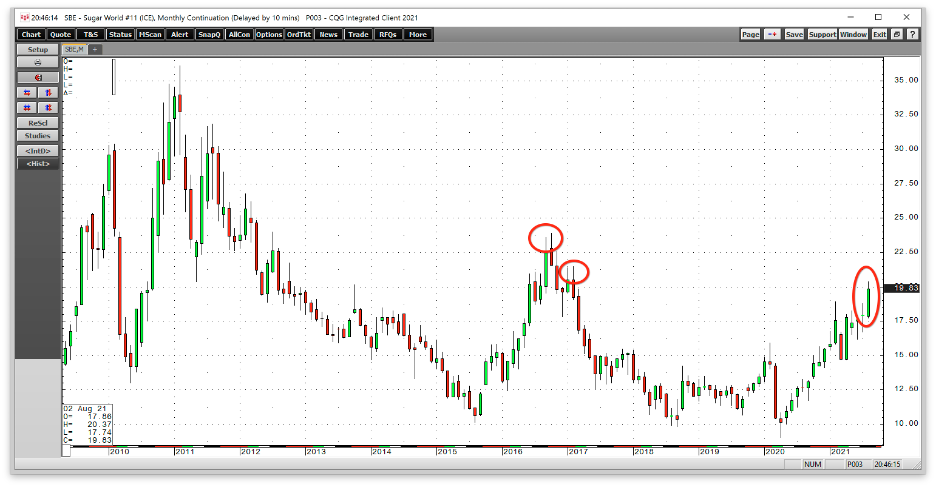
Source: CQG
August was a sweet month for the sugar market as Brazilian weather, inflationary pressures, and logistics lifted the world sugar futures price to 20.37 cents per pound, the highest level since February 2017. The upside target stands at the October 2016, 23.90 cents high.
Source: CQG
Meanwhile, ICE cotton futures prices rose to the most recent high at 97.33 cents per pound in August, the highest level since March 2014 when the peak was only two ticks higher at 97.35 cents.
Four of the five soft commodities rose to multi-year highs in July and August. The fifth is showing signs of bullish life.
Cocoa is showing signs of bullish life
While three of the five soft commodities depend on Brazil for supplies, most cocoa beans come from West Africa. The Ivory Coast and Ghana are the OPEC of cocoa, accounting for more than 60% of the annual production of the primary ingredient in chocolate confectionery products.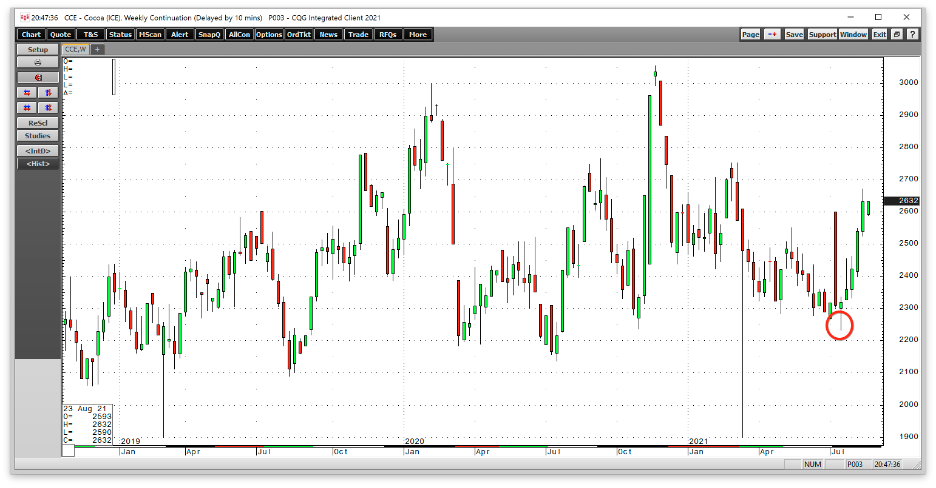
Source: CQG
The weekly chart shows that after falling to a low of $2232 per ton in mid-July when the soft commodity sector was watching coffee explode, cocoa futures have risen over the past weeks, reaching $2,672 per ton during the week of Aug. 16. The high for 2021 stands at $2754. In 2020, it was at $3054 per ton.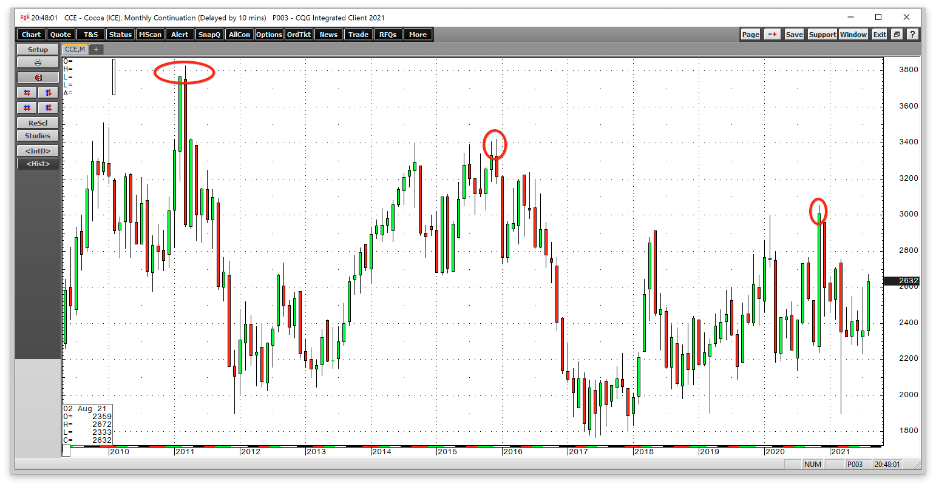
Source: CQG
The monthly chart shows that if cocoa follows the other four soft commodities to multi-year highs, the upside targets stand at the 2020 high and the 2015 $3422 peak. In 2011, cocoa futures reached an all-time high at $3826 per ton, the ultimate upside target.
Levels to watch in the cocoa market - NIB is the cocoa ETN product
Rising inflation is supporting commodity prices across all sectors. Cocoa could be the next commodity to take the bullish baton in the relay race to multi-year or all-time highs. The most direct route for a risk position in the cocoa market is via the futures and futures options that trade on the Intercontinental Exchange. The NIB ETF provides an alternative for market participants looking to position in the cocoa market without venturing into the volatile futures arena. NIB’s fund description states:
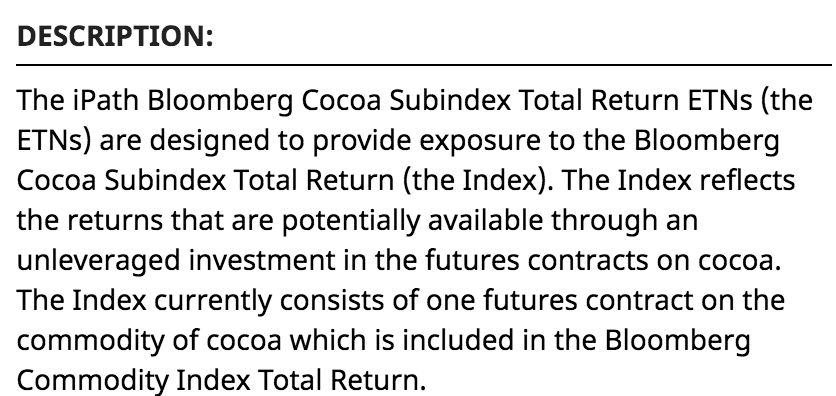
Source: Barchart
The NIB ETN product has $17.852 million in assets under management, trades an average of 52,175 shares each day, and charges a 0.70% management fee.
Nearby cocoa futures rose from $2232 per ton in mid-July to $2672 last week or 19.70%.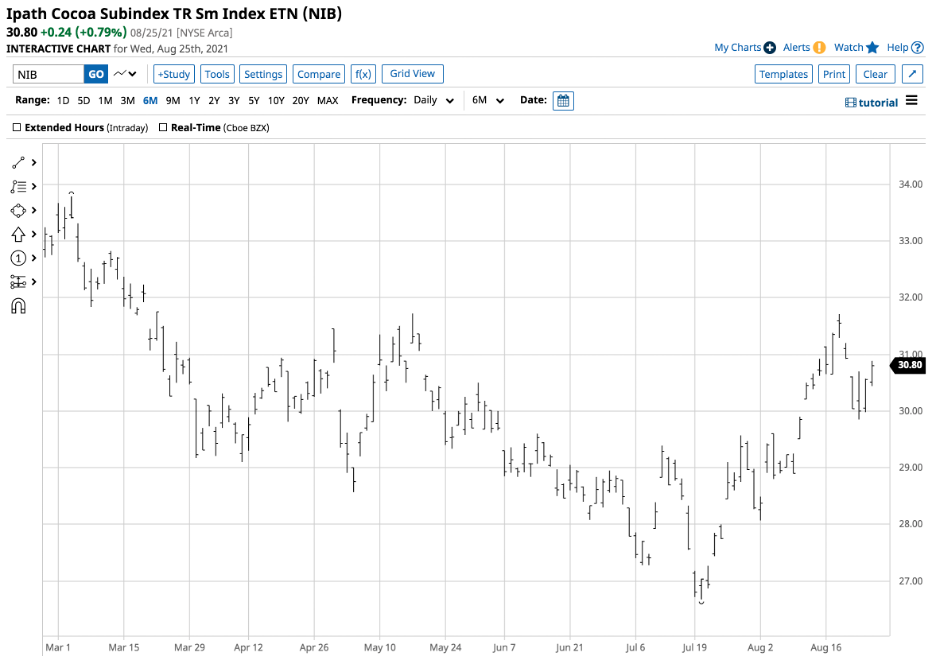
Source: Barchart
The chart illustrates the NIB ETN rose from $26.68 to $31.71 per share or 18.9% over the same period as it did an excellent job tracking the soft commodity price.
If cocoa is set to follow the other four soft commodities performance over the past weeks, we could see the bullish baton pass to the primary ingredient in chocolate over the coming days and weeks.
